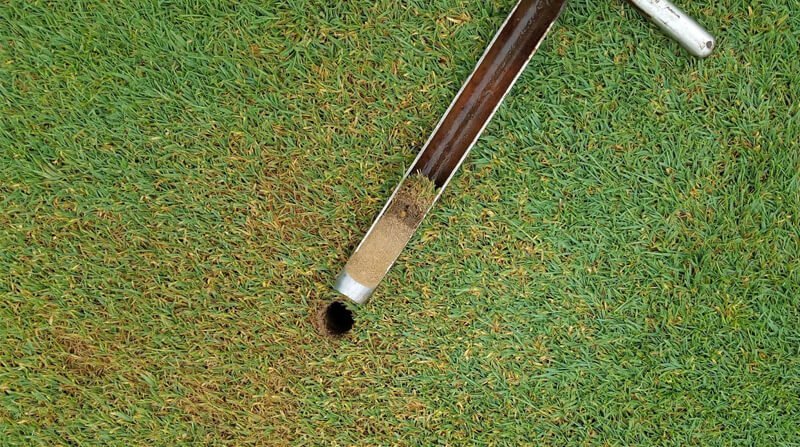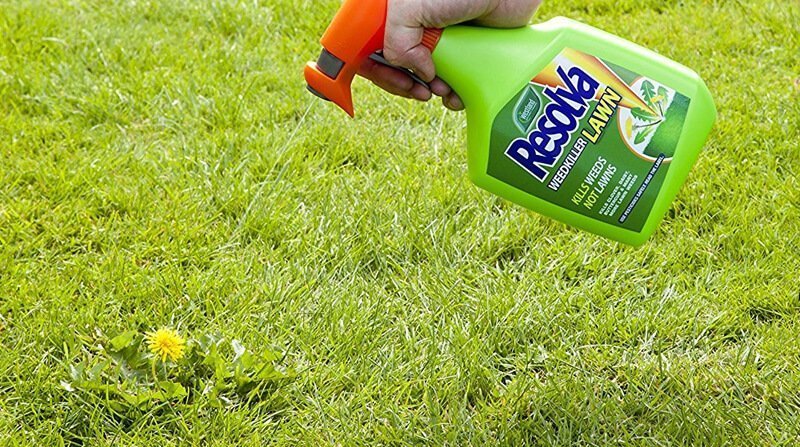Take all patch (formally known at Ophiobolus Patch) is a severe fungal disease that can cause major damage to your lawn.
Thankfully, it’s not very common but if it’s not treated quickly it can take hold and be very difficult to control.
What is Take All Patch?
Take All Patch is a fungal disease caused by the fungus Gaeumannomyces graminis which is common in soil.
Most lawn owners have nothing to worry about when it comes to Take All. However, if you have a lawn which is predominantly made up of bent grasses you could be at risk.
Golf courses regularly suffer from Take All Patch as they use a lot of bent grasses on top of alkaline soil.
What Causes it to Develop?
As I said, the fungus that causes Take All is present in most soils but it can attack the roots, stolons and crowns of the grass of bent grasses.
As you can imagine, because it affects the playing surface of golf courses it has been studied at great depth. That said, experts still don’t understand it fully and so are not able to predict when or why the disease might develop.
What we do know, however, is that the fungus is most destructive when in the summer when temperatures are between 12-18°C. It’s less noticeable in winter.
It also mostly affects soils that are pH 7 or higher. As such, lawns on sandy soils are more at risk than lawns on heavier soils.
Generally, it won’t attack turf for several years but once it makes an appearance, it’ll come back year after year.
What Does it Look Like?

If your lawn is infected by Take All Patch you’ll notice patches or rings of grass with reddish leaves. They will eventually turn brown as the grass dies.
These patches can vary in size. They can be as small as 1-2cm in diameter which means they can sometimes be mistaken for Dollar Spot Disease but can grow to over 3ft or more if left untreated.
You’ll often see other, more tolerant grasses (most likely annual meadow grass) or broadleaf weeds growing in the middle of these patches.
Once the grass is well and truly dead, you might see it turn black as it decomposes. It’ll be easy to pull out or peel back because the roots will have rotted away.
How to Cure Your Lawn of Take All
Like all fungal diseases, the sooner you act, the better chance you have of containing it.
There are no fungicides for controlling Take All which are safe to use at home. But like I said, it only affects bent grasses which means the most obvious way to treat an infected lawn is to overseed with more tolerant grasses like fescues and/or ryegrasses.
If your lawn has an infection of Take All, follow these steps:
Step 1: Apply a Weed Killer

You only need to do this if weeds have grown in the patch of dead grass left by the disease.
It’s easier to kill them now than later.
If there are only one or two weeds, use a spot spray. If your lawn is covered in weeds, use a concentrate and treat the whole thing.
For more information on which is the best weed killer to use, read this article.
Step 2: Rake Your Lawn
Use either a springbok rake or a powered lawn rake to remove any moss or dead patches of grass.
What we’re doing here is removing as much debris as possible to ensure a good contact between the soil and grass seed when it comes to overseeding.
I prefer to use a powered rake that doubles as a scarifier. It’ll make the job much quicker and physically a lot easier. It’ll mean I can use the same machine for the next step.
Read this article to find the best powered lawn rakes and scarifiers.
Step 3: Scarify

Scarifying your lawn will remove thatch, making for a better contact between soil and grass seed.
It will also help to remove any infected and/or dead grass roots, crowns or stolons.
Your lawn might look a bit worse for wear afterwards but don’t worry.
For more information on why, when and how to scarify your lawn, click here.
Step 4: Overseed With New, More Tolerant Grass Seed

Now you have raked and scarified there should be plenty of visible soil on which to spread new grass seed.
Make sure you spread a seed mix which contains grasses that aren’t affected by Take All Patch. Fescues and ryegrasses are perfect.
Depending on the type of lawn you have will depend on the type of grass seed you choose:
- For play areas – use a hard wearing grass seed which consists of only ryegrasses.
- If you have a family lawn that you want to look nice – use a multipurpose seed mix that contains both fescues and ryegrasses.
- For ornamental lawn – use a blend that only contains fescue grasses.
If you want to know more about which grass seed is best for you, click here to read this article.
Also, this article will show you how to overseed your lawn properly.
tep 5: Apply a Pre-Seeding Fertiliser

In order for your new grass seed to germinate and grow as quickly as possible, you’ll need to fertilise your lawn.
Use a pre-seeding fertiliser as it doesn’t contain so much Nitrogen which can be harmful to new seedlings. Instead, it contains a higher concentration of Phosphorus and Potassium to aid strong root development.
This article will show you which fertiliser to use.
Step 6: Brush, Rake, Roll or Tread the Lawn
In order to make sure the grass seed and fertiliser has the best possible contact with the soil you need to brush, rake, roll or tread the lawn.
I prefer to use a brush to work everything into the soil and then use a roller to press it in. That said, you can also use the back of a rake and then tread or ‘heel’ the lawn with very small steps.
Step 7: Water the Area

With everything done, all you need to do is keep the soil moist to aid germination.
If you’re doing this in the autumn as advised then there should be at least some rainfall. If the weather is dry, you’ll need to water for an hour every couple of days.
Use a sprinkler system that has a fine spray setting on it. Watering too heavily will risk drowning the grass seed or washing it away.
Within a few days, you should start to see the grass germinate and grow.
How to Prevent Take All Patch From Re-Occurring
If your lawn has had a really bad infection of Take All Patch, it could take a couple of years for it to heal itself.
You might see a re-occurrence the following year but it should be greatly reduced.
Really the only way to prevent Take All from coming back and ruining your lawn is to avoid using bent grasses altogether.
Each spring and autumn, rake your lawn and overseed with your chosen seed mix. The more fescues and ryegrasses in your lawn, the more resilient it will be to a disease like this.
And I know I keep harping on about it on this website but good lawn care practices as part of an annual care calendar are key to preventing most issues;
- Mow the grass regularly
- Rake in the spring and autumn to remove moss
- Scarify every couple of years to reduce thatch
- Overseed after treatments like raking and scarifying
- Fertilise the lawn at least once a year with a good quality, slow-release fertiliser
- Use a weedkiller to keep on top of weeds
Do all of this, and it doesn’t take long, and you will greatly reduce the chances of having any issues.
In Summary
Take All Patch can be very aggressive in lawns that contain predominantly bent grasses. If not treated quickly it can be very difficult to get on top of, but it can be done.
The only real way to remove and prevent it is to avoid the use of bent grasses.
Over to You
Have you got Take All Patch in your lawn? How are you going to deal with it?
Or what’s your experience of dealing with it?
If you have any questions or something to say, leave a message in the comment section below.

